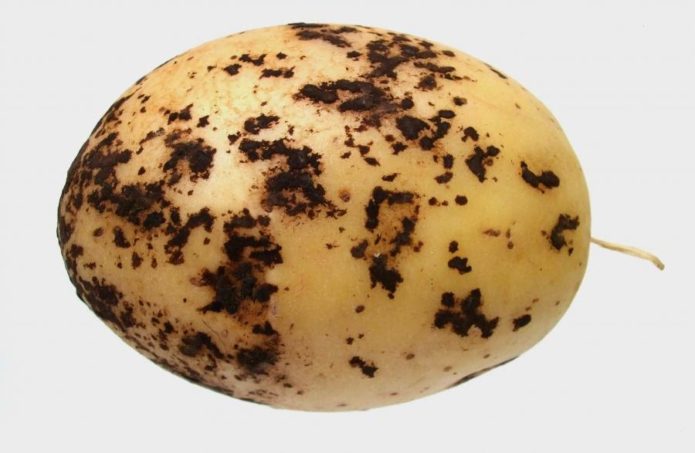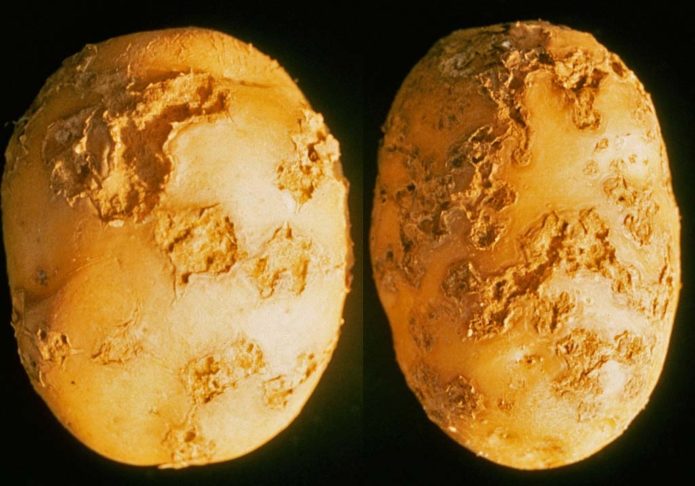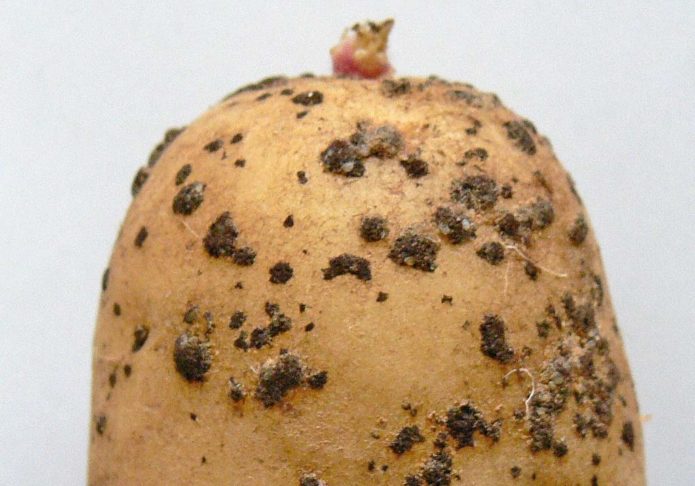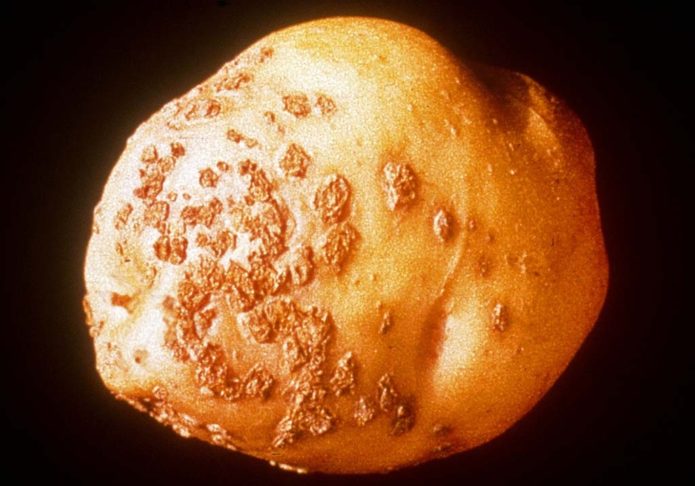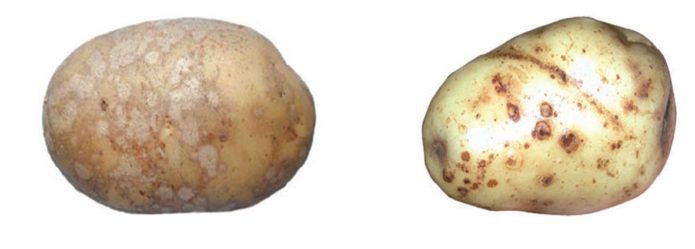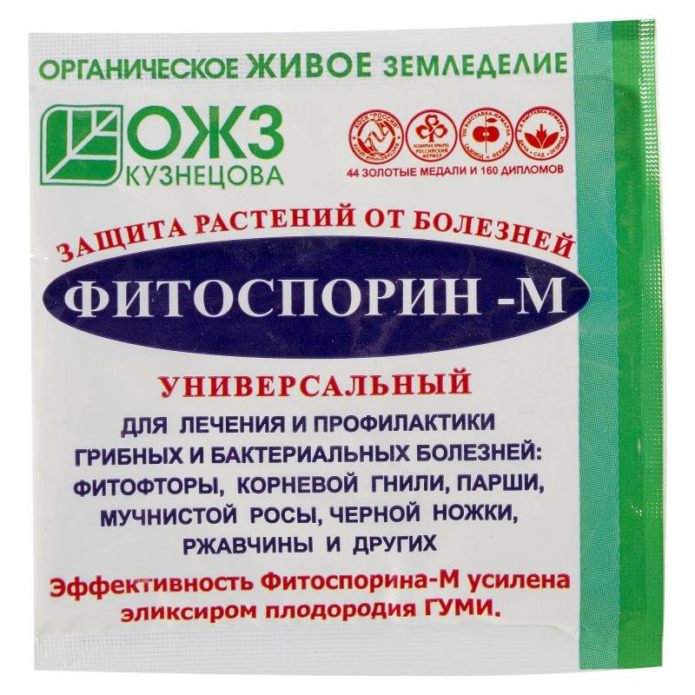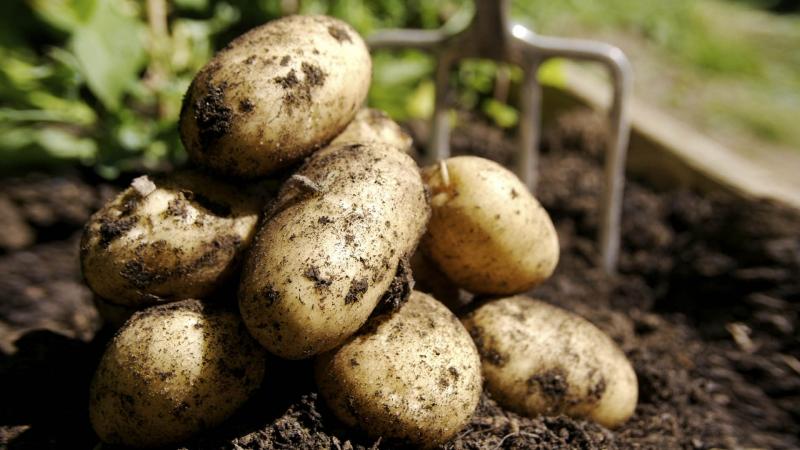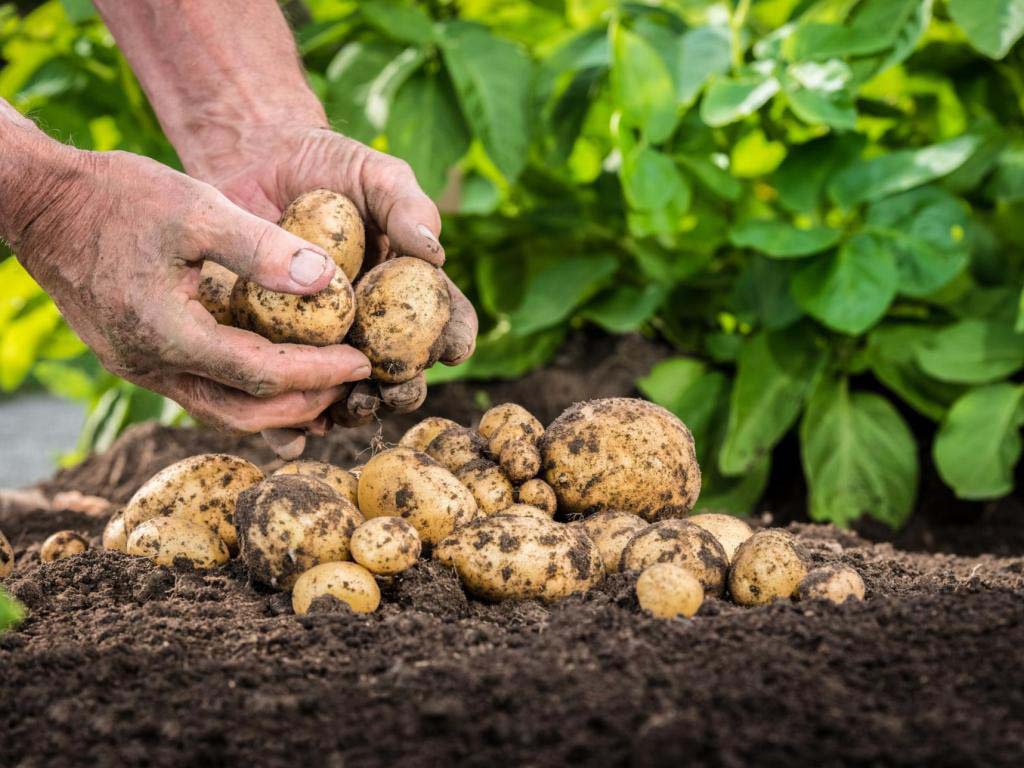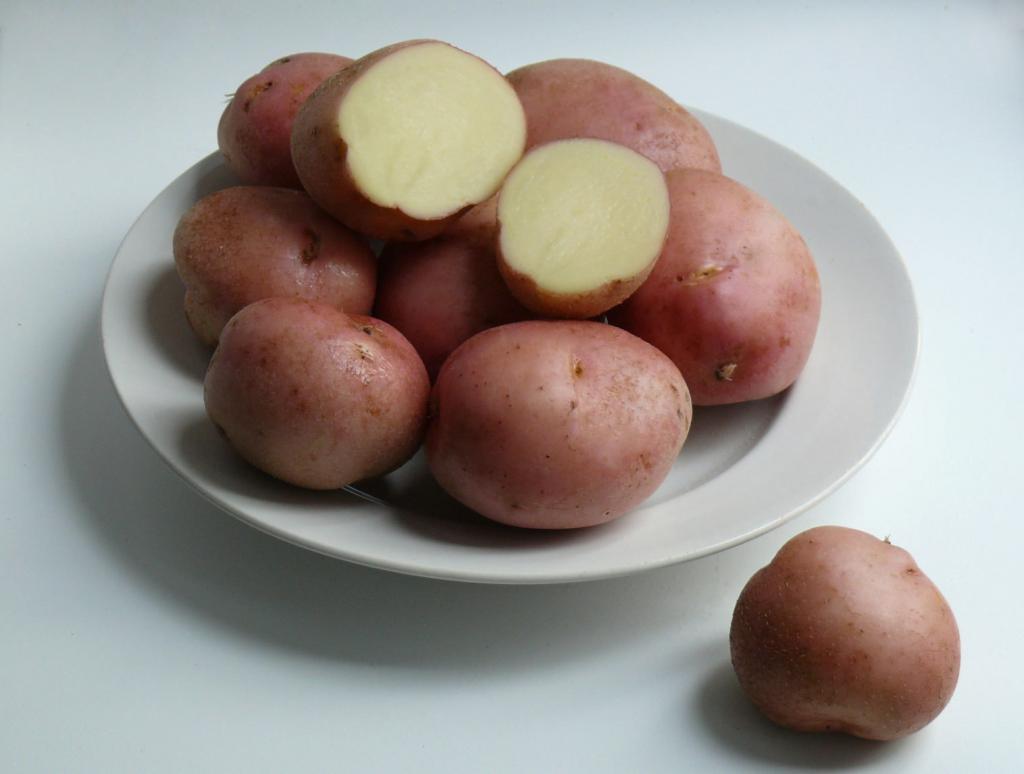Potato scab is a particularly unpleasant fungal disease. The affected area is most often tubers, less often the root system and the underground part of the stem suffer from this disease. There are several types of scab, depending on this, the methods of dealing with it will differ.
Content
What is this type of plant disease
In some years, this infection reduced potato yields by 20–25%.
Even a person who is not involved in phytopathology can distinguish tubers affected by scab from healthy ones. On their surface, bulging and black scabs that resemble small lumps of earth begin to be seen. This condition belongs to the dormant stage of the fungus. He himself appears in the spring, provoked by high humidity.
The appearance of brown ulcers and necrotic spots on the sprouts indicates that rhizoctoniasis began to develop on the plantings. This is the most harmful of all types of scab.
Especially often, a fungal infection develops on light sandy and sandy loam soils.
Types of potato scab and the reasons for their appearance
Scab can appear in four different forms.
The fungus almost instantly spreads over the entire planting area and requires an immediate response.
Regular
Common scab is ubiquitous. It causes superficial damage and sometimes destruction of the flesh during growth. Superficial ulcers are formed on the skin, acquiring a broken, rounded shape. Their diameter can be up to 1 cm. When fused together, these tiny warts can form a crust that covers the entire tuber.
There are four types of common fungal pathologies:
- Flat scab occurs mainly on young tubers and is expressed in the defeat of the outer shell. Rusty-brown scab-like warts form on the fleshy root thickenings.
- The bulging scab got its name from the protruding parts of the fungus crust that cover the tuber.
- Deep scab is an ulcer pressed into the pulp (to a depth of 5 millimeters). Their edges rise noticeably, and the bottom is reddish or purple. This type is found mainly at the beginning of harvesting.
- Reticulated scab differs from other types by the appearance of a continuous rough surface. Fruit ulcers are located in the form of shallow mutually intersecting grooves. They are somewhat reminiscent of a mesh.
The development of this or that type of scab depends on the strength of the impact of damaging microorganisms. This is influenced by potato varieties and environmental conditions.
The causative agents of all of the above types are radiant fungi, or actinomycetes. When infested with them, potatoes lose value:
- there is a deterioration in taste;
- the starch content is reduced to 30%;
- the keeping quality of tubers worsens;
- the appearance of the potato deteriorates.
The pathogen penetrates the underground part of the stem and infects the roots. The processes take place during the first weeks after planting.
Common scab mainly manifests itself on tubers with a thin scarlet skin.
If you bury potatoes deeply in the ground, actively water them during the development of tubers, then the risk of damage by harmful microorganisms will significantly decrease.
Black
A disease that manifests its malignancy in cold and rainy springs. Black scab just has the name of Rhizoctonia in science.
On the surface of the tubers, oblong or rounded outgrowths of various shapes and sizes appear. They look like earthy lumps that stuck to the potato due to high humidity. Such black scabs are not washed off and are scraped off with weight. In this form, this disease almost does not harm the tuber. The fungus inflicts the main damage during the development of seedlings.
Depressed brown ulcers and spots begin to appear on the roots. They often encircle the plant in a ring. In some variants of the development of the disease, brownish streaks appear instead of specks and warts.
The causative agent is a basidiomycete fungus. Comfortable conditions for its growth are from 10 to 28 ° C.
An additional distinguishing feature of Rhizoctonia is green tubers that form in the shoot axils. Bushes subject to basidiomycete remain undersized and underdeveloped. Potato wilt often appears during the daytime. In summer, in warm and rainy weather conditions, black scab can form on adult plants in the form of a "white leg". The spores of the fungi that spread this infection are periodically washed away by the rain and enter the soil from the stem. Thus, they infect new young seedlings.
Deep planting and a delay in harvesting potatoes provoke the defeat of tubers by rhizoctonia.
Powdery
The disease is accompanied by cracking of the skin and the formation of dry brown, star-shaped ulcers. At the bottom of the warts, a crushed mass of brown pollen is released. During the storage period of potatoes, dry stars are slightly smoothed out. For this reason, the powdery scab becomes the common form of this disease.
The disease is caused by the pseudo fungus plasmodiomycete. It reaches the underground parts of the plant and penetrates into its cells, after which it begins its gradual germination. It is a conductor of the dangerous Mop-Top virus. For him, dwarfism of plants, shortening of shoots, paniculate top, mosaic is typical.
Such scab spreads more abundantly on excessively moist and clayey soils in cool climates.
On the vegetative organs of plants, galls are formed - abnormal bulges in the form of growths of irregular shape. At first they turn white, and then gradually begin to brown.
A favorable condition is high moisture soil. Temperatures between 10 and 16 ° C promote the growth of fungi. From the initial stage of infection until the first characteristic signs of the disease appear, approximately 2 weeks pass. The final formation of parasitic spores can be observed within a month.
Affected potatoes are at risk of late blight and black leg in seedlings. Also tubers are subject to rapid decomposition during storage.
Pathogenic microbes are able to remain in the ground and on the seed tubers. Plus, organic fertilizer, consisting of excrement from agricultural livestock, can act as a source of infection. When feeding the animal with infected tubers, the infection maintains viability during its digestion in the animal's digestive tract and subsequent exit from it.
More damage to tubers is observed in peat soils. There are no highly resistant varieties to this disease.
Silvery
Recently, the type of this disease has become widespread. The predominantly silvery scab affects the seed quality of the potato. When planted, affected tubers give weak and rare shoots. Sick tubers, while lying down, are exposed to a secondary infection - pathogens of various rot.
Symptoms appear on tubers already in the fall season. Subtle dark gray spots cover most of the surface of freshly dug potatoes. By the end of storage, the disease reaches its peak. The skin of the tubers acquires a pronounced metallic or silvery sheen. A thin white mycelium begins to appear under the skin, the color of which begins to darken over time. The skin of the potato gradually flakes off the flesh.
Potato infection usually occurs through lentils (small tubercles on the fruit, which serve for gas exchange in it). The sources are soil and tubers that have already been infected with the fungus.
Planting infected tubers leads to severe crop infestation.
How to treat: control measures, chemicals
Contaminated tubers do not threaten human health. They are suitable for consumption, but their composition will carry less nutritional value. Therefore, it is worth knowing what to do if scab appears on the potatoes and how to treat the earth.
Universal means of combating the disease include the use of fungicides, compliance with crop rotation and the use of quality planting material.
There are many products on the market designed to combat scab. But not all of them can be used harmlessly on land.
- Maxim is a contact substance. By eliminating fungus, it supports the beneficial microflora of the earth. Add 2 ml to 50 ml of water, the solution is enough for 50 kg of tubers.
- Fitosporin is a new generation microbiological preparation that is used before planting tubers. They are sprayed with bushes 3 times per season. 3 liters of water are added to one package of the drug, after which the affected area is treated.
- Cuprostat (cuproxat) is a copper-ammonia solution. You need to take 30-60 g, add water to a ten-liter bucket and spray the bushes.
The planted potato variety can also have a beneficial effect. Groups that are completely resistant to scab have not yet been bred, but strong varieties are known. These include:
- Zhukovsky early,
- Favorite,
- Devote,
- Is vain,
- Reserve.
From foreign options:
- Ostara,
- Patrones,
- Prevalent,
- Prosecutor.
How to keep potatoes from scab (prevention)
When choosing a method for preventing scab, one should proceed from the specific type of disease. Each of them has some nuances:
- Germination of seedlings in sunlight will be an effective method of preventing common scab. In addition to this, soil irrigation should be carried out, starting with the development of tubers and continuing for a month;
- A preventive measure for powdery scab will be keeping the seed in formalin solution for 4–6 minutes. Performing this action should be done before planting seedlings in soil;
- The introduction of chalk, lime and other calcium-containing substances at least a year before planting potatoes or in the fall will be an excellent means of fighting black scab;
- The main measure against silvery scab will be timely harvesting in dry conditions. It is also necessary to mow the tops.
Video on the results of preventive measures
Fungi continue to spread rapidly in the agricultural environment. They significantly impair the quality of the crop and its nutritional properties.Careful attention to your garden and taking preventive measures will help reduce the likelihood of developing all sorts of ailments.
